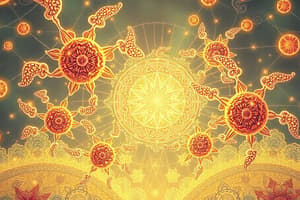Podcast
Questions and Answers
What are intermolecular forces (IMFs)?
What are intermolecular forces (IMFs)?
The various forces of attraction that may exist between the atoms and molecules of a substance due to electrostatic phenomena
Order the following compounds of a group 14 element and hydrogen from lowest to highest boiling point: CH₄, SiH₄, GeH₄, and SnH₄.
Order the following compounds of a group 14 element and hydrogen from lowest to highest boiling point: CH₄, SiH₄, GeH₄, and SnH₄.
CH₄ < SiH₄ < GeH₄ < SnH₄
Order the following hydrocarbons from lowest to highest boiling point: C₂H₆, C₃H₈, and C₄H₁₀.
Order the following hydrocarbons from lowest to highest boiling point: C₂H₆, C₃H₈, and C₄H₁₀.
C₂H₆ < C₃H₈ < C₄H₁₀
What is dipole-dipole attraction?
What is dipole-dipole attraction?
Which has the higher boiling point: N₂ or CO?
Which has the higher boiling point: N₂ or CO?
What is hydrogen bonding?
What is hydrogen bonding?
Hydrogen bonds are much weaker than covalent bonds.
Hydrogen bonds are much weaker than covalent bonds.
Match the following compounds with their boiling points: dimethylether (CH₃OCH₃), ethanol (CH₃CH₂OH), and propane (CH₃CH₂CH₃)
Match the following compounds with their boiling points: dimethylether (CH₃OCH₃), ethanol (CH₃CH₂OH), and propane (CH₃CH₂CH₃)
What is viscosity?
What is viscosity?
What are cohesive forces?
What are cohesive forces?
What is surface tension?
What is surface tension?
What is capillary action?
What is capillary action?
What is condensation?
What is condensation?
What is vaporization?
What is vaporization?
What is dynamic equilibrium?
What is dynamic equilibrium?
What is vapor pressure?
What is vapor pressure?
What is boiling point?
What is boiling point?
What is normal boiling point?
What is normal boiling point?
What is the ∆H of vaporization for water?
What is the ∆H of vaporization for water?
What does ∆H represent in thermodynamics?
What does ∆H represent in thermodynamics?
What is C_s (specific heat of solid H₂O)?
What is C_s (specific heat of solid H₂O)?
What is C_l (specific heat of liquid H₂O)?
What is C_l (specific heat of liquid H₂O)?
What is C_g (specific heat of gaseous water vapor)?
What is C_g (specific heat of gaseous water vapor)?
What is the ∆H of fusion for water?
What is the ∆H of fusion for water?
What is ∆Hsub of H₂O?
What is ∆Hsub of H₂O?
What is the ∆Hdep?
What is the ∆Hdep?
Flashcards are hidden until you start studying
Study Notes
Intermolecular Forces (IMFs)
- IMFs are attractive forces between atoms and molecules due to electrostatic phenomena.
Boiling Points of Compounds
- Order of compounds from lowest to highest boiling point: CH₄ < SiH₄ < GeH₄ < SnH₄.
- Compounds are nonpolar and experience dispersion forces; larger molecules lead to stronger dispersion.
Hydrocarbons Boiling Points
- Order for hydrocarbons from lowest to highest boiling point: C₂H₆ < C₃H₈ < C₄H₁₀.
- All hydrocarbons are nonpolar with London dispersion forces; boiling points increase with molecular size.
Dipole-Dipole Attraction
- Occurs between the partially positive end of one polar molecule and the partially negative end of another.
- Only polar molecules exhibit this attraction.
Comparison of N₂ and CO
- CO has a higher boiling point due to its polarity and dipole-dipole attractions.
- Both have the same mass but CO’s dipole forces are stronger than N₂'s dispersion forces.
Hydrogen Bonding
- A strong dipole-dipole attraction occurs when hydrogen is bonded to fluorine, oxygen, or nitrogen.
- Large electronegativity differences and small size of hydrogen lead to concentrated partial charges.
Strength of Hydrogen Bonds
- Hydrogen bonds are about 5-10% as strong as covalent bonds but are stronger than other dipole-dipole attractions and dispersion forces.
Boiling Points of Dimethyl Ether, Ethanol, and Propane
- IMFs strength order: Propane (only dispersion forces) < Dimethyl Ether (dipole-dipole) < Ethanol (hydrogen bonding).
- Boiling points: Propane: -42.1 °C, Dimethyl Ether: -24.8 °C, Ethanol: 78.4 °C.
Viscosity
- Defined as a liquid's resistance to flow; stronger IMFs result in greater viscosity.
Cohesive Forces
- IMFs existing between identical molecules of a substance contribute to liquid surface behavior.
Surface Tension
- Energy required to increase the surface area of a liquid, caused by cohesive forces at the liquid's surface.
Capillary Action
- Phenomenon where liquid flows in porous materials due to molecular attraction to the surface and themselves.
Phase Changes
- Condensation involves the transition from gas to liquid.
- Vaporization refers to the change from liquid to gas.
Dynamic Equilibrium
- A condition where vaporization and condensation processes occur at identical rates.
Vapor Pressure
- Maximum vapor pressure of a liquid at a given temperature; it remains constant if the temperature is stable.
Boiling Point Definition
- The temperature at which a liquid's vapor pressure equals the applied external pressure.
Normal Boiling Point
- Boiling point at an external pressure of 1 atm (101.3 kPa).
ΔH of Vaporization for Water
- Energy required to convert one mole of liquid water to vapor: 40.7 kJ/mol.
Specific Heat of Water
- Specific heat values: solid H₂O: 37.6 kJ/mol, liquid H₂O: 75.1 kJ/mol, gaseous water vapor: 33.1 kJ/mol.
ΔH of Fusion for Water
- Energy needed to convert one mole of liquid water to solid: ΔH (fus) H₂O > 0, 6.02 kJ/mol.
Sublimation of Water
- Energy required to convert solid water to gas, skipping the liquid phase: ΔHsub = ΔHfus + ΔHvap, ΔHsub > 0.
ΔHdep
- Energy required to convert one mole of water vapor directly into solid ice: ΔHdep < 0, ΔHdep = -ΔHsub.
Studying That Suits You
Use AI to generate personalized quizzes and flashcards to suit your learning preferences.




